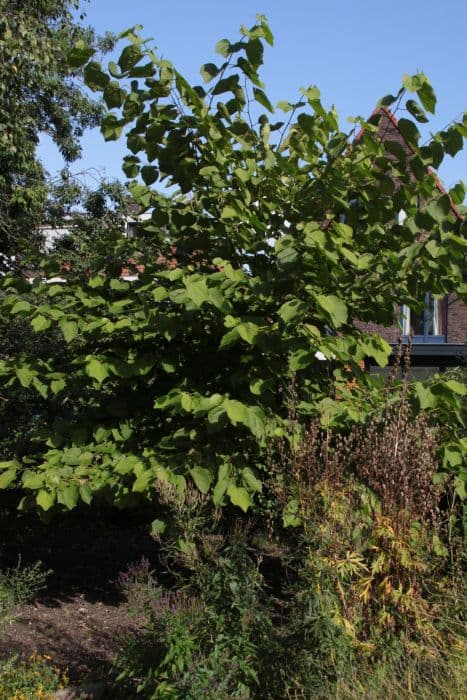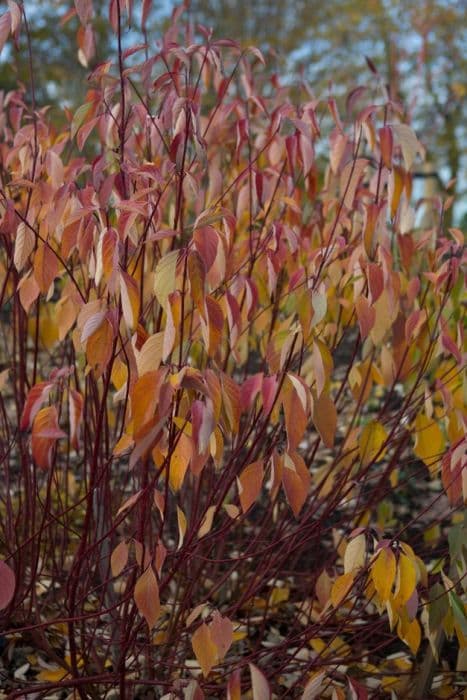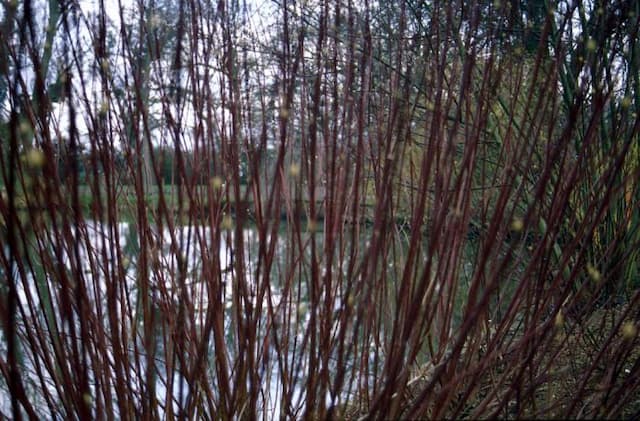Kousa Dogwood Cornus kousa 'Wolf Eyes' (v)











ABOUT
Cornus kousa 'Wolf Eyes' is a visually striking variegated cultivar of the Kousa dogwood known for its distinctive foliage and ornamental appeal. The leaves of this plant are oval-shaped with pointed tips and exhibit a bold variegation pattern. Each leaf is edged with a creamy white or off-white border, contrasting beautifully with the green center. The leaves' variegation gives the canopy a shimmering effect, especially when it flutters in the breeze, adding a textured look to the landscape. In addition to the attractive foliage, the Kousa dogwood 'Wolf Eyes' produces a profusion of star-shaped flowers that are not actually flowers but bracts, which are specialized leaves. These bracts start as a greenish color and gradually mature to a creamy white hue that complements the variegated leaves. The pattern of bracts usually consists of four pointed lobes arranged in a cross shape with a small, inconspicuous cluster of yellowish-green true flowers at the center. As the season progresses, the Kousa dogwood 'Wolf Eyes' also bears berry-like fruits which add another layer of interest. The fruits typically have a pinkish-red color and a somewhat bumpy texture and are attractive to birds and wildlife. The bark of 'Wolf Eyes' is another feature that provides year-round interest. As the plant matures, the bark develops an exfoliating texture, peeling away in patches to reveal a mosaic of earthy tones underneath. This characteristic bark adds to the plant's overall texture and visual appeal, especially in the winter months when the leaves are gone. Overall, the appearance of Kousa dogwood 'Wolf Eyes' is enchanting, with its striking variegation, elegant floral display, attractive fruit, and textural bark, which all contribute to its popularity as a landscape plant. Its ability to provide multi-seasonal interest makes it an excellent choice for gardeners who are looking to add lasting beauty to their outdoor spaces.
About this plant
 Names
NamesSynonyms
Kousa Dogwood, Korean Dogwood, Chinese Dogwood, Japanese Dogwood, Variegated Kousa Dogwood.
Common names
Cornus kousa 'Wolf Eyes'
 Toxicity
ToxicityTo humans
The Kousa dogwood 'Wolf Eyes' is generally not considered toxic to humans. The fruit of the Kousa dogwood is actually edible and is sometimes made into wine or jelly. However, plant parts other than the fruit, such as the leaves and bark, are not typically consumed by humans and should be considered potentially harmful due to the risk of stomach upset if ingested in large quantities.
To pets
The Kousa dogwood 'Wolf Eyes' is not known to be toxic to pets. The fruit is edible for humans and is not commonly known to cause harm to pets either. However, it is always best to prevent pets from eating large amounts of any non-food plants, as they could potentially cause gastrointestinal upset or an allergic reaction in sensitive individuals. If a pet does ingest a large amount of the plant and shows symptoms of distress, it is advisable to contact a veterinarian.
 Characteristics
CharacteristicsLife cycle
Perennials
Foliage type
Deciduous
Color of leaves
Variegated
Flower color
White
Height
10 feet (3 meters)
Spread
10 feet (3 meters)
Plant type
Shrub
Hardiness zones
5
Native area
Asia
Benefits
 General Benefits
General Benefits- Ornamental Appeal: The 'Wolf Eyes' Dogwood is highly prized for its variegated foliage, which adds visual interest to the landscape.
- Four-Season Interest: This cultivar offers year-round beauty with its spring blooms, summer leaves, autumn colors, and distinctive winter bark.
- Disease Resistance: It has improved resistance to common dogwood pests and diseases compared to some other species.
- Low Maintenance: Once established, it requires minimal care, making it a suitable choice for many gardeners.
- Drought Tolerance: It can tolerate periods of drought once mature, making it suitable for regions with occasional water restrictions.
- Wildlife Habitat: The plant produces berries that are attractive to birds, providing a valuable food source.
- Shade Tolerance: 'Wolf Eyes' Dogwood can thrive in both full sun and partial shade, giving it versatility in a garden design.
 Medical Properties
Medical Properties- This plant is not used for medical purposes.
 Air-purifying Qualities
Air-purifying QualitiesThis plant is not specifically known for air purifying qualities.
 Other Uses
Other Uses- Culinary Ingredient: The fruits of Kousa dogwood can be used to make jams, sauces, or wine.
- Dye Production: The bark of the tree can be utilized as a source for creating dyes for fabrics or crafts.
- Woodworking Material: Kousa dogwood wood is hard and can be used for specialized small-scale woodworking projects like tool handles and inlays.
- Insect Breeding: The flowers of the Kousa dogwood attract beneficial insects, thus can be used to support local bee or butterfly populations.
- Photography Subject: Its striking variegated foliage and distinct fruit make Kousa dogwood a popular subject for botanic photography and plant studies.
- Educational Resource: The tree is sometimes used in educational settings to teach about plant biology and hybridization due to its cultivated variety status.
- Ornamental Crafts: The branches and bracts can be used in floral arrangements and crafts for decoration.
- Cultural Symbolism: In some cultures, parts of the Kousa dogwood tree might be used symbolically in art or ceremonies.
- Landscape Architecture: Kousa dogwood can be utilized in landscape design to provide seasonal color and to create focal points in gardens and parks.
- Wildlife Shelter: The dense foliage provides shelter and nesting sites for small animals and birds.
Interesting Facts
 Feng Shui
Feng ShuiThe Kousa dogwood is not used in Feng Shui practice.
 Zodiac Sign Compitability
Zodiac Sign CompitabilityThe Kousa dogwood is not used in astrology practice.
 Plant Symbolism
Plant Symbolism- Beauty: The 'Wolf Eyes' Kousa Dogwood is known for its distinctive variegated foliage and beautiful white flowers, representing natural beauty and aesthetic appeal.
- Resilience: As a hardy variant of the Kousa Dogwood, it symbolizes the ability to withstand challenges and adapt to various conditions.
- Renewal: The flowering of the Dogwood tree is one of the first signs of spring, symbolizing new beginnings and the cycle of life.
- Purity: The Dogwood tree’s white flowers are often associated with purity and innocence.
- Christian Symbolism: Some believe the Dogwood is connected to Christian symbolism, where the shape of the flower represents the crucifixion of Jesus, thus symbolizing faith and rebirth.
 Water
WaterKousa dogwood 'Wolf Eyes' prefers a consistent watering schedule, especially during the first growing season to establish a deep root system. Water the plant deeply once a week, providing about 1.5 to 2 gallons per session for young trees, and more for established trees depending on the tree size and soil conditions. During hot, dry spells, additional watering may be necessary. Be sure to adjust the watering schedule during rainy periods to prevent overwatering. It's also beneficial to use mulch to help retain soil moisture.
 Light
LightKousa dogwood 'Wolf Eyes' thrives in conditions where it receives partial shade to full sun. A location receiving morning sunlight with some afternoon shade is ideal to protect its variegated leaves from excessive sun, which can cause leaf scorch. However, it can tolerate a fair amount of sunlight if the soil moisture is consistent.
 Temperature
TemperatureKousa dogwood 'Wolf Eyes' can tolerate a wide range of temperatures, from a winter low of approximately -10°F to a summer high that can exceed 100°F. The ideal growing temperatures for this plant are between 60°F and 75°F. Ensure it is protected from harsh winter winds to prevent damage to the variegated foliage.
 Pruning
PruningPrune the Kousa dogwood 'Wolf Eyes' to remove any dead or damaged branches, to shape the tree, and improve air circulation within the canopy. Pruning should take place in late winter or early spring before the new growth begins. Light pruning can also be done after the flowering period to maintain the desired shape.
 Cleaning
CleaningAs needed
 Soil
SoilKousa dogwood 'Wolf Eyes' thrives in well-draining, rich, acidic soil with a pH between 5.5 and 6.5. The best mix is one part peat, one part loam, and one part sand or perlite to facilitate good drainage while retaining adequate moisture.
 Repotting
RepottingKousa dogwood 'Wolf Eyes' does not typically require frequent repotting and is usually planted in the landscape rather than containers. If grown in a pot, it may need repotting every 2-3 years to refresh the soil and expand the root space.
 Humidity & Misting
Humidity & MistingKousa dogwood 'Wolf Eyes' prefers average outdoor humidity levels. As a landscape plant, it typically adapts to the local humidity conditions and does not require additional humidity control.
 Suitable locations
Suitable locationsIndoor
Grow in bright, indirect light with moist soil.
Outdoor
Plant in partial shade, protect from harsh sun and wind.
Hardiness zone
5-8 USDA
 Life cycle
Life cycleCornus kousa 'Wolf Eyes', also known as Kousa Dogwood 'Wolf Eyes', begins its life cycle with seed germination, which typically takes place in spring after a period of cold stratification. Following germination, the seedling stage involves the development of the primary root, stem, and first true leaves. The plant then enters into a vegetative growth phase, where it expands its root system, branches, and foliage, and may take several years to mature before it's capable of flowering. Once mature, the Kousa Dogwood 'Wolf Eyes' enters the reproductive stage, producing characteristic white to pink flower bracts in late spring to early summer, which are followed by berry-like fruits that attract birds. After the flowering and fruiting stage, the plant enters a period of senescence in late fall to winter, losing leaves and entering dormancy to survive cold temperatures. This cycle repeats annually, with the plant potentially living for decades, continuing to grow in size and spread.
 Propogation
PropogationPropogation time
Late winter to early spring
The Kousa dogwood 'Wolf Eyes', a variegated cultivar, is most commonly propagated through softwood cuttings. This method typically takes place in late spring to early summer when the plant's new growth is just beginning to harden but is still flexible. To propagate by cuttings, select a healthy stem with new growth, cutting a 4- to 6-inch piece with a sharp, sterilized knife or pruners. The bottom leaves are removed, and the cutting is dipped in rooting hormone to encourage root development. The treated cutting is then inserted into a pot filled with a mix of peat and perlite or sand, ensuring that the leaf nodes are buried where roots will form. The pot needs to be kept under high humidity, often achieved by placing a plastic bag or dome over it, and in indirect light until roots have established, which usually takes several weeks. Once rooted, the new Kousa dogwood 'Wolf Eyes' can be transplanted into a larger pot or directly into the garden during the appropriate planting season.









